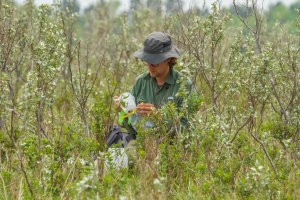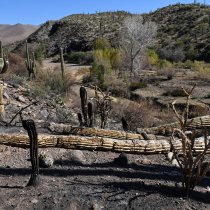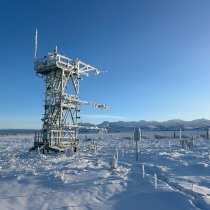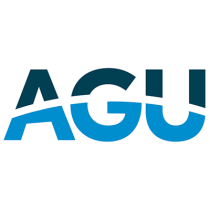Domain Digest No.2: NEON Partners with Tribal Colleges for D09 Undergraduate Research Experience
November 24, 2021
In August 2021, Domain 09 (Northern Plains) welcomed ten students from regional Tribal colleges and universities, along with some of their parents, for a day of hands-on activities and exploration at two NEON field sites. The day was planned in collaboration with the American Indian Higher Education Consortium (AIHEC) as part of an ongoing effort to reach out to Indigenous students and communities in the areas where the NEON program is active.
A Day in the Field in D09
The program, which was supported through a grant from the Bureau of Indian Affairs (BIA) Tribal Climate Resilience Program, is part of a Research Experience for Undergraduates (REU) for students at Tribal colleges and universities (TCUs) throughout the Plains region. Alexis Archambault, a graduate student at the University of North Dakota, helped to organize the trip as part of a larger REU around ecosystem change and resilience, for which she is acting as an advisor. Andrea Anteau, the Field Operations Manager for D09, coordinated and hosted the trip from the NEON side.
The trip came about when Al Kuslikis, the Senior Associate for Strategic Initiatives at AIHEC, reached out to Katie Jones at NEON with the idea. He explains, "It was a one-time pilot project, a proof of concept to establish that we could successfully recruit, prepare and support TCU students conducting change-related research in their communities. The NEON site visit provided an opportunity for our REU students to tour an important ecological research facility and interact with research personnel there. In addition to being an interesting learning experience, it provided a great example of where an ecological/environmental research career pathway can lead."
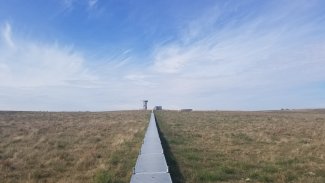
Flux tower at WOOD field site in North Dakota
Participating students represent several TCUs in the Plains states. They toured two colocated field sites in North Dakota: the Chase Lake National Wildlife Refuge (WOOD) terrestrial site and the Prairie Pothole (PRPO) aquatic site. Field staff explained the goals and design of the Observatory and introduced students to some of the sampling protocols at each site. At PRPO, students got to participate in some mock aquatic sampling activities led by Danielle Farkas, a D09 Field Ecologist. In between field activities, students and their parents enjoyed a picnic lunch on the prairie.

Prairie Pothole (PRPO) aquatic field site
Anteau was struck by the enthusiasm and engagement demonstrated by both the students and parents. "I was really touched by how engaged they were and the thoughtful questions they asked," she says. "The day really contributed to a lot of intergenerational inquiry. From the perspective of the parents, I was surprised at how quickly they made the connection between the kinds of data we are collecting here at NEON and the observations they make from a cultural perspective." Several of the students also expressed interest in applying for future seasonal field technician positions. This fall, many of them are continuing with ecology projects leveraging large datasets and remote sensing data from NEON and other large-scale ecology networks.
Supporting Scientific Sovereignty for Indigenous Peoples
Outreach to and support for the Native communities who live in the areas in which the NEON program operates is an important part of our mission. For Katie Jones, a Plant Ecologist for the Terrestrial Observation System, it is also personal. A member of the Amskapi Piikani (Southern Piegan Blackfeet) tribe, Jones attended Blackfeet Community College before moving on to other educational opportunities. She says, "I experienced the unique education model that honors both traditional and western knowledge systems in the curriculum. My vision in the NEON-AIHEC collaboration is to facilitate relationship building where NEON staff are learning from the communities connected to the lands we are working on, while sharing the resources and opportunities (educational and professional) available in the NEON network."
Making connections with Indigenous communities is especially urgent in the face of ecosystem change. Many Native communities in North America are especially vulnerable to the impacts of ecosystem change. Al Kuslikis says that these realities make it critically important to get young people from these communities involved in ecology and the environmental sciences. "Native communities in the U.S. and Indigenous communities globally are among the most vulnerable to ecosystem change impacts. Given that there are not nearly sufficient resources available to support the adaptation work needed, every Indigenous community needs to draw on its own human and other resources to achieve a sustainable level of resilience, given that ecosystem change pressures to resilience are not only going to continue into the foreseeable future, but will likely intensify."
Kuslikis also thinks that NEON can be an important resource for the students and communities he serves. "NEON can provide opportunities for training students and community members in ecological research tools and methods; explore research partnerships with Indigenous communities using a citizen-science model specifically adapted to incorporate local knowledge; and assist Tribal communities with the development of plans for monitoring local ecosystem priorities, like the status of the habitats of locally significant plant and animal species."
For Jones, collaborations like the one with AIHEC are an important part of supporting scientific sovereignty for Indigenous peoples. "My emphasis is on providing data skills training and professional experiences to support students' learning objectives and enable data-driven decision making as one tool for community response to change." She is actively working with other initiatives, such as Rising Voices, focused on resilience for Native communities. She hopes to see more collaborative initiatives between NEON, AIHEC and other organizations supporting Indigenous students and communities.
The benefits of these collaborations are very much two-way. The NEON program gains from having the voices and experiences of Tribal elders and students. Anteau says, "Here in North Dakota, Indigenous communities are the original observers of the landscape, and many of them still rely on the land for both food and spiritual sustenance. They have a vested interest in understanding how their lands are changing. Having people from outside the NEON program come to our field sites and share their perspectives is very energizing, because we are here for the public. It's important to get their thoughts and feedback so we understand how the work we are doing can be utilized in their communities."
Jones is excited to see more of these two-way conversations blossoming between NEON and Native communities across North America. "We're still early in the process, but we need to be asking questions and be open to other, non-Western ways of knowing and to the priorities and concerns of these communities. We are always learning from the students and communities we interact with. Ultimately, that makes science better and more usable for everyone."
